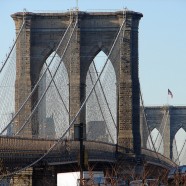
Normally most people associate branding with a product, service or company, not a geographic locale. But the brand image is very important for countries, states or cities as well. The right image can attract new residents, investments, entrepreneurial start-ups and positive notoriety that will enhance the overall brand equity for a place, enriching the perceived value of living and/or working there.
At its core, branding is all about developing an emotional relationship with customers. The targeted audience will ideally consist of people who can identify with what the brand offers, view it as different, relevant to their needs/desires, and derive great value from experiencing that brand.
As in the case of many cities, younger people have changed New York in many positive ways, despite the downside of forcing older or poorer residents to new areas because they can no longer afford the higher rent. In the 1960’s-80’s, the Upper East Side of Manhattan was THE place to live, followed by the West Side and Greenwich Village as other fun (and safe) locations. During the 1990’s, with this steady stream of young people moving into NYC, other “fringe” areas in Manhattan were targeted for gentrification – the East Village, SoHo, Tribeca, the Lower East Side, Chelsea, NoHo, etc. Rents skyrocketed and these new, hot areas attracted more and more young people with high salaries, especially from the banking and financial service industries. The safety measures initiated by Mayor Giuliani attracted an even greater influx of younger people, especially after the 9-11 attacks, from all over the world to the Big Apple, which typically meant Manhattan.
This expansion and change in profile for these peripheral areas in Manhattan created a new dilemma for those college educated young adults who tended to be more creative, entrepreneurial or charitable minded, but could not afford these higher costs with their more modest incomes. Instead they turned to Brooklyn and its attractive neighborhoods like Prospect Park. Then the real “hipster” types went further to heretofore ethnic neighborhoods and completely overhauled locations like Williamsburg, Carroll Gardens, DuMBo, Fort Greene, Bushwick and even parts of Bay Ridge (truth be told, where I was born – in the Norwegian Hospital there). In fact, the hipsters of Bushwick have more in common with those in Dalston, the hipster district in London, than they do with peers in the Upper East Side.
With this dramatic transformation over the past decade, Brooklyn is considered today one of the hottest, most trendy places in the northeast, and even the world (I even noticed a few people with “Brooklyn” tee shirt in London when I visited in May). For Brooklyn, as a brand, it is the new people flooding into this borough that are creating a new “brand experience” that is refreshingly unique. They feel comfortable with, even passionate about this new environment, and they want to communicate and share its benefits with other like friends.
Almost overnight, the impact of the exciting lifestyle and atmosphere of these young, entrepreneurial Millennials spread throughout Brooklyn, revitalizing its overall brand identity. Other concurrent events contributed to this perception of Brooklyn being the latest hot spot to live and work – e.g. the expansion of Brooklyn Lager, which found placement in stores and bars around the country (including pubs in London), the strong emotional ties to Brooklyn of the new mayor, Bill DeBlasio, and the success of the new Barclay Center showcasing the Brooklyn Nets and frequent concerts with top stars.
What can we learn from this transformation of Brooklyn that will improve our ability to create powerful brands? First and foremost, your customers are in an opportunistic position to help shape your brand, especially in today’s world of digital communications. They can develop a new personality for any brand. For Brooklyn, which has more distinct, older neighborhoods or “villages” than Manhattan (e.g. similar to London), these hipster types found less expensive apartments, stores and restaurants which they could more easily transform into more unique venues.
The driving force behind this renaissance of “brand Brooklyn” goes beyond the economic opportunities for trend setters, however. There are strong emotional ties that are associated with any effort to revitalize new neighborhoods – e.g. an underlying passion and allegiance from such rejuvenation, plus the comfort levels and trust one develops when living and working with similar personalities and values. All these emotions are critical for successful re-branding, especially building brand trust among your customers.
Finally these newcomers to Brooklyn became “brand evangelists”. While no one manipulated the profile or influx of these “early adopters”, their impact via digital media to build awareness and attract more of the same types of “customers” is an example of how brands can cost effectively create a very relevant and compelling brand personality that will lead to success.
For more insights on how to build emotional brands, see previous blogs and articles in my website, http://thepathfindergroup.net/resources/.
By: Diego Torres Silvestre – CC BY 2.0



Very articulate and insightful look at an old borough.